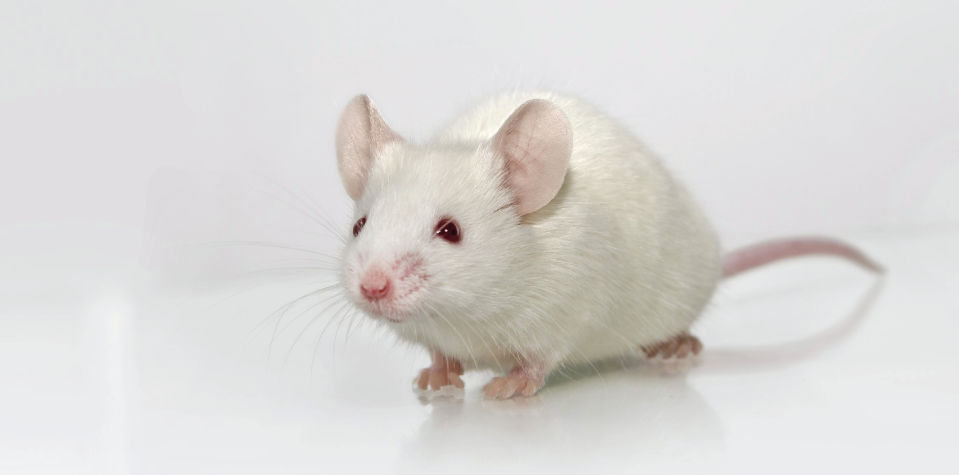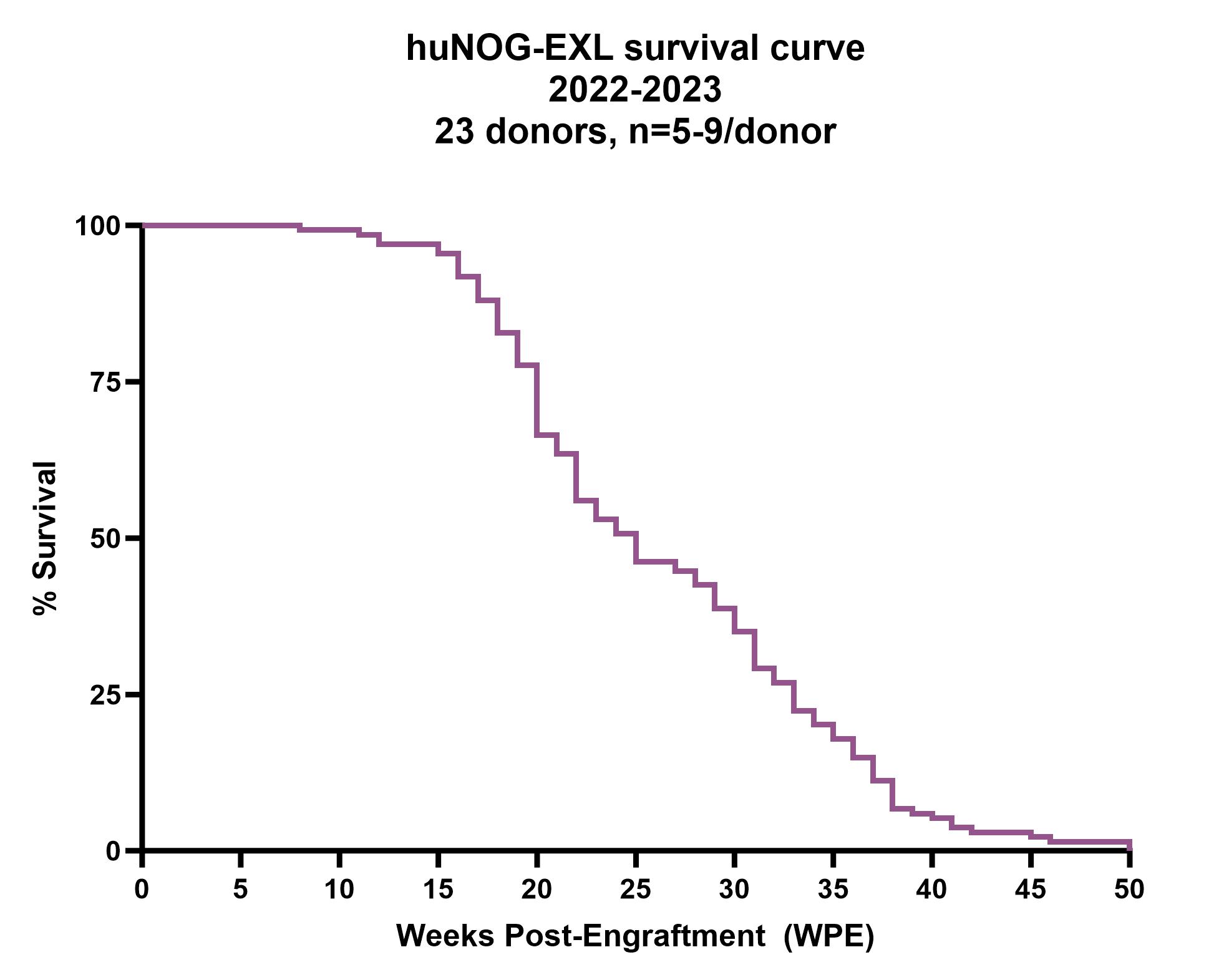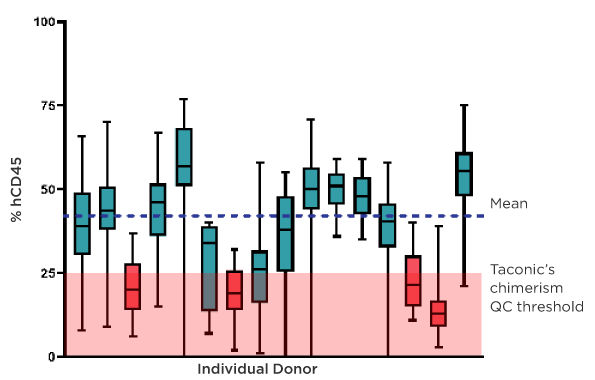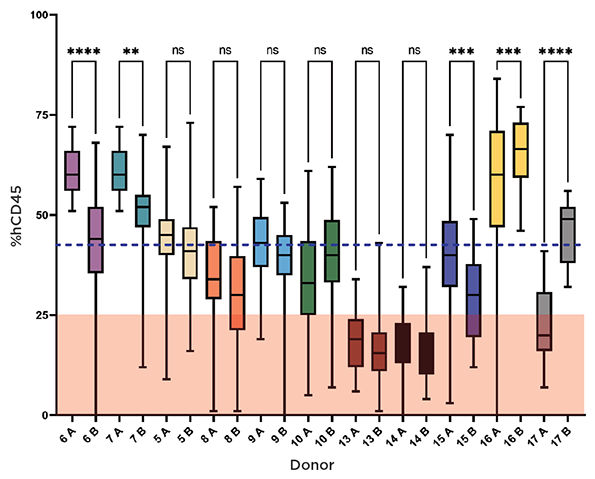Extend your study window with the leading CD34+ HSC-engrafted humanized immune system model that offers a longer average lifespan and superior levels of B, T, and myeloid cells.
Humanized Immune System Mice
huNOG-EXL Model Portfolio

NEW! Improve the quality and consistency of your studies by reducing donor-to-donor variability in CD34+ HSC engrafted models.
Learn More about our huSelect™ Custom Humanization Services!
Humanized Immune System (HIS) Mice Supporting Both Myeloid and Lymphoid Cells
HIS mice are powerful tools for immuno-oncology research, but reliable engraftment of key human immune cell populations can be a challenge. The Taconic huNOG-EXL models recapitulate essential aspects of the human immune system for accurate and translatable results.
All huNOG-EXL models feature:
- Expert engraftment of CD34+ HSC cells
- Differentiation of both human myeloid and lymphoid cells due to human IL-3 and GM-CSF transgene expression
- Superior levels of human cell engraftment
- Longer average lifespan compared to other strains that support myeloid cells
- Simple terms of use for academic, industry, and CRO studies
In addition, the FcResolv® huNOG-EXL mouse improves accuracy in preclinical studies by knocking out murine Fc gamma receptors that interfere with antibody-based therapies. Learn more about FcResolv® NOG models.
Two delivery offerings to meet your experimental needs
Taconic offers a flexible choice of two delivery options to support a variety of study timelines. Contact us for an expert consultation if additional guidance is needed.
Standard Access (SA): Live inventory, ready to ship

Diagram of Standard Access (SA) huNOG-EXL mice SA starts with (1) engraftment of NOG-EXL mice with CD34+ HSC cells. (2) At 10 weeks post engraftment (WPE) mice undergo flow cytometry analysis to ensure a minimum of 25% chimerism and are made available for sale. (3) Upon order, mice are shipped within 1-2 weeks. (4) The study window begins once mice are received and acclimated. (5) While Taconic has observed that huNOG-EXL mice can often survive for 25+ weeks post-engraftment (WPE), researchers should plan for studies to be complete by 23-26 WPE.
Early Access (EA): Made to order using validated CD34+ donors

Diagram of Early Access (EA) huNOG-EXL mice EA mice start with (1) an order being placed. (2) Validated CD34+ HSC donors are used to engraft a suitable number of mice, and (3) animals are shipped within ~2 weeks (4) researchers now have a longer possible study window, prior to emergence of T cells or during the peak B cell period. (5) While Taconic has observed that huNOG-EXL mice can often survive for 25+ weeks post-engraftment (WPE), researchers should plan for studies to be complete by 23-26 WPE.
Supporting Data
- Which huNOG-EXL model is right for you?
- huNOG-EXL mice have extended lifespan compared to competing models
- Kinetics of Human Immune Cell Reconstitution in huNOG-EXL (Peripheral Blood)
- How Taconic Addresses HIS Mouse Variability
- huNOG-EXL EA Mice are Engrafted Using Donor Cells with Proven Engraftment Success
- Hematopoiesis and Humanized Immune System Mice
Which huNOG-EXL is right for you?
Taconic offers two humanized versions of the NOG-EXL mouse as part of our HIS mouse portfolio - huNOG-EXL and FcResolv® huNOG-EXL. The FcResolv® huNOG-EXL models offer all of the same benefits of human IL-3 and GM-CSF transgene expression for support of myeloid and lymphoid cells, but also feature knockout of murine Fc gamma receptors to improve accuracy of study results with antibody-based therapeutics.
The Standard Access (SA) and Early Access (EA) models are available at different timepoints post-engraftment. Use the table below to help determine the model best suited for your study. Contact us for an expert consultation if additional guidance is needed.
| Early Access (EA) | Standard Access (SA) | |
|---|---|---|
| Price | + | ++ |
| Timeline | 5-6 week order lead time; shipped 1-2 WPE | Inventoried at 10+ WPE and ready to go on study after a short acclimation |
| Available for experimental manipulation prior to 10 WPE | Yes | No |
| Chimerism QC data available | No | Yes |
| Who assumes the risk that individual animals fail to engraft? | Customer | Taconic |
| % mice guaranteed to meet QC standard | N/A | 100% |
| Maximum n-value per donor | 35-40 mice | 35-40 mice |
| Minimum purchase | 20 mice | No minimum |
| Cancellation policy | May not be canceled after order is booked | Cancellation deadline 4 weeks prior to ship date |
huNOG-EXL mice have extended lifespan compared to competing models

Survival curve for huNOG-EXL mice across 23 donors (n=5-9 per donor), generated in the Taconic Biosciences humanization core during 2022-2023. The huNOG-EXL has the longest demonstrated lifespan compared to competing models; this varies by donor and can be impacted by environmental and experimental factors. All myeloid-supportive HIS mice have limited lifespans due to a range of outcomes including anemia, thrombocytopenia and myeloid cell hyperactivation syndrome (Internal Taconic data).
Kinetics of Human Immune Cell Reconstitution in huNOG-EXL (Peripheral Blood)

huNOG-EXL mice support high levels of human immune cells in peripheral blood (chimerism) and develop both myeloid and lymphoid cells. huNOG-EXL EA mice are shipped shortly after engraftment, prior to reconstitution of significant numbers of human immune cells in peripheral blood. huNOG-EXL SA mice are shipped after a QC step to confirm that each mouse has ≥25% human cells in peripheral blood at 10 weeks post-engraftment.
How Taconic Addresses HIS Mouse Variability
Donor characteristics impact human immune system reconstitution in huNOG-EXL mice, including chimerism levels and frequencies of specific human immune cell types. As shown in the graph of huNOG-EXL SA models below, engraftment lots for which the mean falls below Taconic's 25% chimerism threshold are disqualified from sale (shown in red). For lots with a mean above the threshold (shown in blue), any individual animals in the lot which score below 25% are disqualified from sale. For huNOG-EXL EA, Taconic selects donors that have previously been validated to reduce the risk of lot failure. Taconic's Field Application Scientists can help you design a successful study plan which appropriately accounts for both inter- and intra-donor variation in HIS mice and select the right huNOG-EXL version for your research.

huNOG-EXL EA Mice Are Engrafted Using Donor Cells with Proven Engraftment Success
In order to determine the level of engraftment in huNOG-EXL models, HSCs from the same donor were engrafted twice, on separate days, to generate two lots of huNOG-EXL mice per donor. The ability of a donor to produce lots where most mice either met or failed the QC threshold of ≥25% chimerism was replicated between duplicate lots, with one exception in this test set. To generate huNOG-EXL EA mice, Taconic chooses donors with proven engraftment success in order to reduce the risk of lot failure.

Hematopoiesis and Humanized Immune System Mice

Both huNOG-EXL SA and EA models develop human myeloid and lymphoid lineages.
huNOG-EXL Models FAQs
The huNOG-EXL EA (Early Access) model is better suited for a longer study such as those with slow-growing patient-derived xenografts or tumor cell lines. Both huNOG-EXL models have a limited lifespan (as with all myeloid-supportive HIS models), but utilizing the huNOG EA allows research studies to begin sooner, thereby accommodating studies that take more time.
Blood sampling can negatively affect the health and well-being of huNOG-EXL mice. To mitigate this, Taconic recommends that blood sampling be limited to once in a two-week period in both huNOG-EXL EA and SA models. Taconic's FAS are available for consultation regarding sampling questions in these models.
Yes. Both huNOG-EXL EA and SA models require special housing and husbandry conditions, as well as proper acclimation and enrichment. Taconic has composed a comprehensive document for customers looking to order a humanized model. Please review Licensing, Care & Resources for Taconic's Humanized Immune System Models and Video: Care of HIS mice for experimental success prior to ordering.
The huNOG-EXL EA and SA models both support the differentiation of multiple human lineages including T, B, and NK cells and various myeloid cells. While not all human immune cell types have been exhaustively characterized in these mice, extensive myeloid differentiation including granulocyte differentiation (basophil, neutrophil and mast cells) are evident in blood and tissues. Antigen presenting cells (dendritic cells and macrophages) are also increased in frequency, both in blood and spleen. Consultation with a Taconic FAS can help you design a project that studies specific cell type(s) of interest in a huNOG-EXL or recommend another model, if more appropriate for the relevant cell type.
Prior immune system humanization results (immune cell profiles, %chimerism, etc.) are not guaranteed to repeat due to the many circumstances that impact immune cell engraftment (diet, handling, housing, etc.). However there is strong evidence to support improved reproducibility across studies when engraftment using the same donors is repeated.
The pre-characterized donors are recommended for use in huNOG-EXL (HSCCB-13395). We can custom engraft any model (in addition to our HSCCB strains) using validated (EA) donors or any of our other huSelect options (selected HLA status, etc.)
Featured Resources
Need assistance?
Contact Taconic for questions about ordering, product availability, or selecting the best model for your needs.
Get In Touch
Book a complimentary consultation or get support for an existing order
If you need immediate assistance, please contact Customer Service:
Taconic Corporate Offices
Email: info@taconic.com
Phone: +1 (518) 697-3900
273 Hover Ave., Germantown, NY 12526
North American Customer Service
Email: info@taconic.com
Phone: +1 (518) 697-3915
Toll-free: +1 (888) 822-6642
Hours: (Monday - Friday): 7 a.m. - 6 p.m. ET
European Customer Service
Email: info@taconic.com
Phone (Europe and Denmark): +45 70 23 04 05
Phone (Germany): +49 214 50 68 023
Hours: (Monday - Friday): 7 a.m. - 5 p.m. CET
















.jpg)

.jpg)
.jpg)
.jpg)
.jpg)





.jpg)


.jpg)
.jpg)




.jpg)




.jpg)

.jpg)












